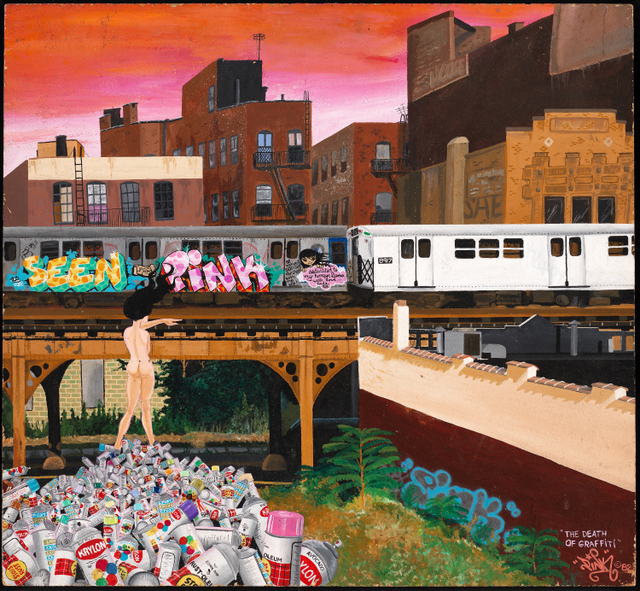 Lady Pink, Death of Graffiti, acrylic on masonite, 1982.
Lady Pink, Death of Graffiti, acrylic on masonite, 1982.
The Museum of City of New York’s upcoming City as Canvas: Graffiti Art from the Martin Wong Collection, is the first exhibition of the 1970s and ’80s graffiti art amassed by artist and pioneering collector Martin Wong. The exhibition features important paintings and “black book” drawings by some of the earliest graffiti artists in New York City, including DONDI, DAZE, FUTURA 2000, Keith Haring, LA2, LADY PINK, LEE, SHARP, ZEPHYR, and many more. We recently had a chance to chat with Sean Corcoran, who curated the upcoming exhibition.
Untapped Cities: Tell us a little bit about the artwork in the exhibit.
Sean Corcoran: The exhibition will have about 130 objects from the collection. There will be a combination of works on canvas, works on paper, blackbook drawings, photographs and other media. There is even a painting on a refrigerator door by an artist named Quik!
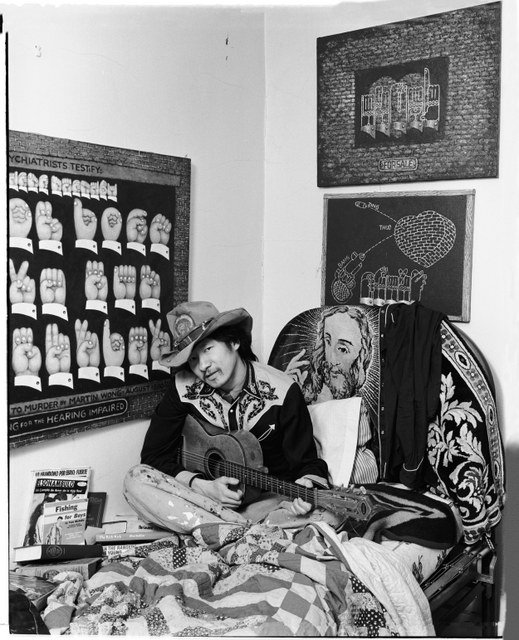
Untapped: Do you have any particular favorite pieces in the show?
SC: There is a painting in the collection made by Lee Quiñones that is a reproduction of one side of his famous handball court murals he created on the Lower East Side. [The original mural had been created 10 years earlier and has since been destroyed]. The mural has “Howard the Duck” painted on one side and on the other side is a work titled, “Lion’s Den”. We have a reproduction of the “Howard the Duck” mural in the collection. What makes the painting so special to me is that Lee made the reproduction specifically for Wong because he desperately wanted to find a way to preserve the entire wall. We also have several preparatory sketches by Lee, as well as photos by Charlie Ahearn of the two completed murals. I think that little grouping is pretty great.
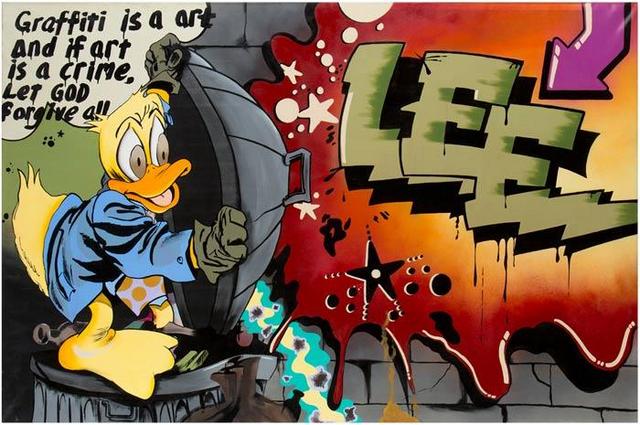 Lee Quiñones, Howard the Duck, oil on canvas, 1988.
Lee Quiñones, Howard the Duck, oil on canvas, 1988.
SC: One other object in the collection that is very rare is an early tag collection, circa 1970-72, which we identify as the “Wicked Gary Tag Collection.” Wicked Gary, a writer and founding member of the Ex-Vandals graffiti writing club (the first ever of its kind), gathered tags, or signatures, from his fellow writers during his travels around the city on little pieces of cardboard. His collection of about 70 tags, acquired by Wong in the 1980s, were assembled into a wooden frame. Pieced together, it is really exceptional.
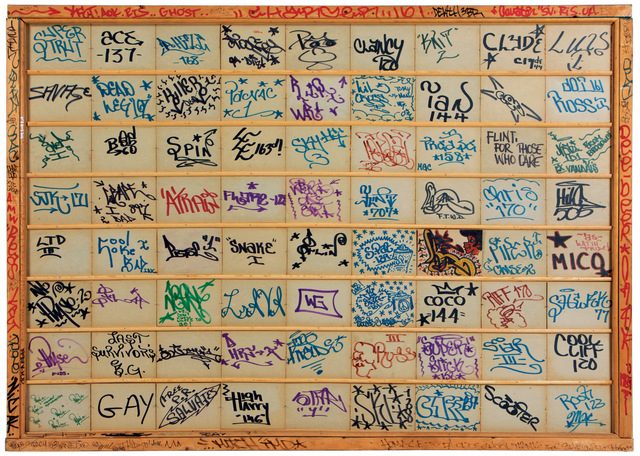 Various Artists, Wicked Gary’s Tag Collection, 1970-72
Various Artists, Wicked Gary’s Tag Collection, 1970-72
Untapped: What makes the “Wicked Gary Tag Collection” so exceptional?
SC: These tags are extremely rare examples of the earliest days of graffiti writing in New York City. Most of the time tags were written on walls, buses, and trains, so over time they were completely erased from the city. Graffiti writers were just starting to write in each other’s black books, but by and large, no one was really collecting these tags with the future in mind. Very few of these types of things persist. Gary was very self-conscious in his effort to gather these, and that’s why it is such a rare thing.
Untapped: Can you tell us about any research or preservation work involved?
SC: We have 55 black books, and generally each page of each book has work on it by either the owner of the book or other artists. Therefore, each page needed some research to figure out who created the work and when it was made. Verifying attributions took years of research to decipher hand styles and aliases. This was the case not only for the black books – we had to do this for many canvases as well. Once that verification was done, we finally really understood the contents of the collection. Then we were able to make informed judgments on what is important to include in a book or an exhibition and what tells the story.
We also reviewed the condition of each object in the collection. We had professional conservators review the condition and prepare the works for display. Almost every canvas in the show was minimally cleaned of dust. We treated this collection the way we treat all the artwork in the museum’s collection – the way every artwork deserves to be treated – with respect.
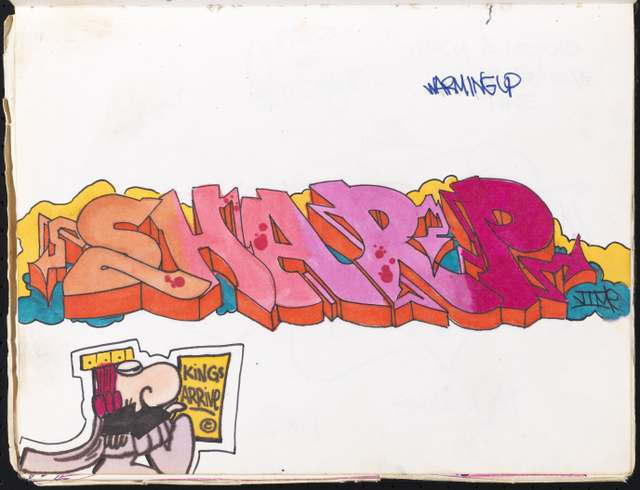
Sharp, ink on paper, from a blackbook. 1983
Untapped: What was it like to curate a show like this?
SC: In some ways I am curating from a collection that’s already been curated [by Wong], so I am trying to find the best objects in the collection that give a window as to what he was interested in, and his relationship to the culture.
Untapped: Graffiti on the streets is traditionally very ephemeral, and most of the time it disappears. Many of the objects in this exhibition must be very rare.
SC: Yes. People saw graffiti in the city, and no matter what they thought of it, everyone knew it was ephemeral and wasn’t going to be there forever. Some works painted on trains lasted up to a couple of years, but generally there was an acknowledgement that it was going to be cleaned, or “buffed” as those in the culture say. Same with murals on walls – they knew eventually they were going to disappear.
The things that did persist are the black books, which artists filled with drawings and where they would gather drawings from their writer friends as well. It is really uncommon for these to be seen outside of the artists’ circles and a rare window into the culture for non-writers. The exhibition features several exceptional black book drawings by important figures including Phase 2, Tracy 168, Blade, Dr. Revolt and Zephyr.
Eventually, many graffiti writers made work on canvas. These works have endured for obvious reason – they were done intentionally as “art.” They were made to last, and made to be shown in galleries and hung in people’s homes.
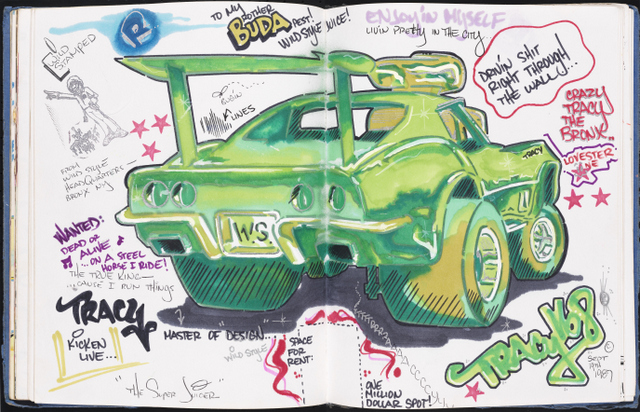 Tracy 168, Acrylic and ink on paper from a black book. 1987.
Tracy 168, Acrylic and ink on paper from a black book. 1987.
Untapped: Photography endures too. Can you tell us about the photography in the exhibit? What was the relationship between photographers and writers of that era?
SC: Since we wanted to show the Martin Wong Collection in a historical context we decided to include a number of photographs of graffiti on the trains and on the streets. At the time, there were a handful of photographers documenting the graffiti art movement throughout the 70s and 80s including Jon Naar, Jack Stewart, Henry Chalfant, and Martha Cooper. All are featured in the exhibition.
Remember, they were young teenagers who were doing graffiti. Sometimes they were wary about meeting new people, especially adults. All of these photographers had to prove to these kids that they were not there to have them arrested. Once the writers discovered the photographers’ motives were positive they sometimes even became friends. Henry [Chalfant] and Martha [Cooper] would have kids call them and tell them about their new work on trains. The relationship became almost symbiotic because the photographers were documenting things that were not going to last.
Untapped: What might this show teach both graffiti writers and enthusiasts, as well as to visitors who may not know anything about the art?
SC: The exhibition serves two purposes: First, it presents the collecting vision of Martin Wong, himself a well-regarded painter, and his appreciation for the work of these other young individuals. On another level, the exhibition shows the impact and enduring legacy that these talented young people had on the city. What these young artists did still has relevance today, worldwide. There are young kids painting trains in Switzerland today because of what these artists were doing in the 70s and 80s. Today’s graphic designers choose certain styles to market products based on the cultural impact these artists made back then. The work they were were doing at the time still resonates and that is what people will see in these paintings.
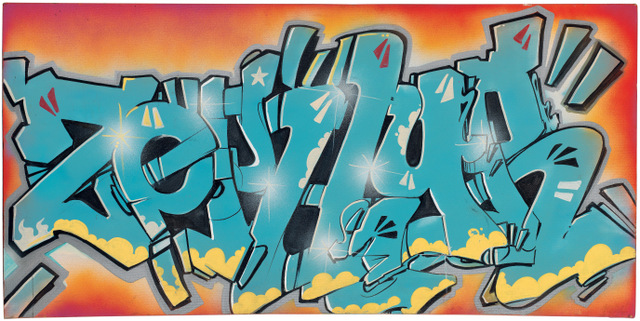 Zephyr, Untitled, acrylic on canvas, 1984.
Zephyr, Untitled, acrylic on canvas, 1984.
Untapped: What about the timing of the City as Canvas show? Why now?
SC: I do think it is the right time for this exhibition. These days there is a larger acceptance of graffiti, and maybe it is partially because graffiti is off the trains and not quite as prolific on the street as it used to be. But, there is obviously a deeper appreciation for street art right now. After 5 pointz was closed and whitewashed, you saw the public outcry and there was a lot of love for the place. There was also the recent “Banksy-mania” here in New York. There is a difference in what we are showing and modern day’s street art – but our exhibit does essentially show the origins of street art…. the style just permeates pop culture today. It is so prevalent and so much a part of our lives that it makes sense right now to look back at the origins of this phenomenon. This year also marks the 20th anniversary of Martin’s donation of his collection to the City Museum.
Mark your calendars – City as Canvas will open Tuesday, February 4 and remain on view until Sunday, August 24, 2014. In conjunction with the exhibit, MCNY has two great public programs coming up in February. The first is Graffiti 101: New York Subway Art of the 1970s and 80s on Wednesday, February 12 at 6:30 pm, and the second is The Art of Graffiti: Draw Your Name on February 15 from 2:00 pm to 3:00 pm.
Get in touch with the author at Rachel Fawn Alban





